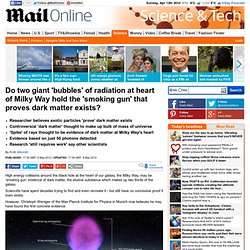

The mystery of black hole at centre of galaxy: 'Sleeping dragon' erupted two million years ago. For 20 years scientists had suspected that a huge outburst had occurredEvidence now suggests the black hole did in fact erupt two million years agoExplosion was so powerful that it lit up a cloud 200,000 light years awayAstronomers predict that a gas cloud called G2 could cause activity in the black hole early next year By Ellie Zolfagharifard Published: 18:29 GMT, 25 September 2013 | Updated: 19:15 GMT, 25 September 2013 The mystery as to why our galaxy’s supermassive black hole is dormant has stumped scientists for decades.

But new evidence suggests that the ‘sleeping dragon’ was in fact active at some point- we just weren’t around to see it. Astronomers claim that the supermassive black hole erupted two million years ago in an explosion so immensely powerful that it lit up a cloud 200,000 light years away. Scroll down for video... While scientists had previously predicted that such an outburst had occurred, this is the first time they have been able to say when it happened.
NASA space telescope shows there may be 17 billion Earth-like planets in Milky Way. Chances of finding extra terrestrial life boosted by latest analysisNasa believes almost every sun-like star could have at least one planet461 potential planets identified by the Kepler mission since February 2012Dramatic increase in number of Earth-sized planets By Damian Ghigliotty Published: 06:57 GMT, 8 January 2013 | Updated: 16:43 GMT, 8 January 2013 Enough planets exist in the Milky Way to ensure that there is at least one for each of the hundred million stars in the galaxy, NASA has revealed.

Analysis of data from the Kepler space telescope shows that 17 billion planets in the galaxy are Earth-like in size. The findings are making scientists increasingly confident of finding a rocky planet the same size as Earth, with a similar orbit and situated in the 'habitable zone' of a solar system. Scroll down for video. The Milky Way as you've never seen it before: New pictures from nine GIGAPIXEL camera reveal our galaxy in unprecedented detail.
Unique view is a monumental 108,200 by 81,500 pixel colour image containing nearly nine billion pixels iIf printed with the resolution of a typical book, it would be 9 metres long and 7 metres tall By Mark Prigg.
The stunning image revealing a massive halo of hot gas that envelops our galaxy. Milky Way only settled into current state just as Earth and Sun were forming. By Daily Mail Reporter Published: 18:49 GMT, 21 October 2012 | Updated: 17:31 GMT, 22 October 2012 Disc galaxies like our own Milky Way were believed to have been formed billions of years ago but now scientists have discovered it only settled into its present state at around the time the sun and Earth were forming.

Do two giant 'bubbles' of radiation at heart of Milky Way hold the 'smoking gun' that proves dark matter exists. Researcher believes exotic particles 'prove' dark matter existsControversial 'dark matter' thought to make up bulk of mass of universe'Spike' of rays thought to be evidence of dark matter at Milky Way's heartEvidence based on just 50 photons detectedResearch 'still requires work' say other scientists By Rob Waugh Published: 17:39 GMT, 9 May 2012 | Updated: 17:39 GMT, 9 May 2012 High energy collisions around the black hole at the heart of our galaxy, the Milky Way, may be ‘smoking gun’ evidence of dark matter, the elusive substance which makes up two thirds of the galaxy.

Sciencitts have spent decades trying to find and even recreate it - but still have no conclusive proof it even exists. However, Christoph Weniger of the Max Planck Institute for Physics in Munich now believes he may have found the first concrete evidence. Just like the chocolate bar, the Milky Way galaxy is 'full of bubbles', say scientists. By Rob Waugh Published: 16:39 GMT, 8 March 2012 | Updated: 17:58 GMT, 9 March 2012 Just like the fluffy nougat in the chocolate bar, the Milky Way galaxy is full of bubbles, a new survey by 'citizen scientists' has found.

More than 35,000 astronomy fans sifted through data from the Spitzer space telescope, and found bubbles in space - blown out by young, hot stars into the gas and dust around them. Volunteers for the project are shown a small section of Spitzer¿s huge infrared Milky Way image (left), which they then scan for cosmic bubbles. Supermassive black hole will 'eat' gas cloud at heart of Milky Way galaxy. By Eddie Wrenn Updated: 15:54 GMT, 27 June 2012 Next year will see one of the biggest collisions ever observed by man.

A giant gas cloud will hit the massive black hole - known as Sagittarius A - which lies at the centre of our galaxy in 2013. Actually, the cloud will miss by quite a distance - 24,000,000,000 miles to be semi-exact - and while this is quite a distance (indeed it takes light 36 hours to travel that far), the tidal forces of the black hole will rip the gas cloud apart. One observer will be Stefan Gillessen, an astrophysicist at the Max Planck Institute for Extraterrestrial Physics in Munich, Germany, who has been observing the black hole for the last 20 years. He said: 'So far there were only two stars that came that close to Sagittarius A.
As the cloud gets closer, it's speed gets quicker - it has doubled its speed in just seven years. Gamma rays set to stun: Mystery of the two gigantic 'beams' that blasted out of the heart of the Milky Way a million years ago. By Rob Waugh Published: 16:49 GMT, 29 May 2012 | Updated: 06:34 GMT, 30 May 2012 Two gigantic beams blasted out of the centre of the Milky Way a million years ago - intensely powerful blasts of energy that would have required a black hole devouring a mass 10,000 times that of our Sun. 'The faint jets we see today are a ghost or after-image of what existed a million years ago,' said Meng Su, an astronomer at the Harvard-Smithsonian Center for Astrophysics, after the Fermi Space Telescope detected traces of the blasts.
